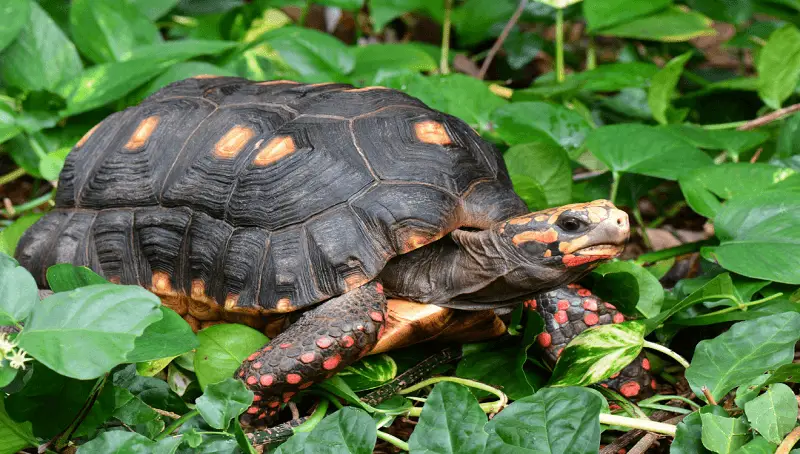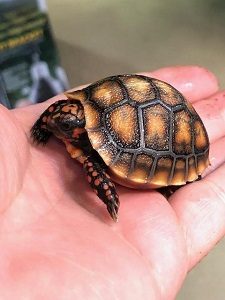
When Should Puppies Stop Biting?
July 18, 2022
Common Problems of Inbreeding in Dogs
July 20, 2022
Red-footed tortoises have become one of the most popular exotic pets in the past few years. They are truly attractive and require very little maintenance, making them a perfect exotic pet for beginner owners and tortoise sellers.
In this article, I will tell you everything you need to know about taking care of a red-footed turtle. Even though these animals have very little maintenance needs, there are still a few things you need to know before you get one.
General information about the red-footed tortoise
As you may have realized from their name, red-footed turtles are named like this for the glowing scales on their feet. In addition to being very eye-catching, they bloom in captivity and have quite a relaxed temperament.
These turtles are found naturally throughout South and Central America. Because they are found on such a wide body of land, they live in a variety of environments, ranging from wet forests to dry savannahs.
Due to their attractive appearance and light nature, they are one of the top turtles in the reptile trade. Beginners and experienced turtle owners alike love to watch these relaxed and light creatures. Not to mention, they can last decades in captivity.
You might also like my articles on the Russian tortoise, the Red-eared Slider, and whether tortoises can eat celery or not.
As with any other turtle, the most difficult part of owning a red-legged turtle is securing the proper habitat inside your home. As long as you install the tank properly, the turtle should be happy and healthy for many years.
How much do Red-footed tortoises cost?
Because red-footed turtles are so sought after and found only in very specific parts of the world, these turtles may be a little expensive, but they are nowhere near as expensive as other species of turtles.
You can expect to pay between $150 and $500 for a turtle. The older the turtle, the more expensive it will be. The price does not include the cost of the tank, food, and care of the turtle.
Typical behavior and temper
As I have already said, one reason why people love red-footed turtles is that they are relaxed and calm. They don’t tend to be aggressive.
Although these turtles do not like to be held so much, they are not as impulsive as other turtles. Do not forget to be gentle and do not make sudden noises or movements around them, and the turtle will be truly happy.
Appearance and variety
Red-footed tortoises are very easily identifiable because of their unique appearance. Like any other tortoise, its body is completely covered with thick scales. Most of the scales on the body are dark in color, including colors such as brown, black and gray.
Around their legs, you will also see a pop of red, orange, or yellow. The exact shade of the scales will depend on the region from which the turtle belongs. The tops of the turtle’s shell are also much lighter than the rest of the scales. These tips are usually pale yellow, creating a three-dimensional design on the shell.
As for the head, red-footed tortoises have a flat tip, and their faces also tend to be pale yellow. Often, the scales on the face match the lighter colorings found on the rest of the body.
How to take care of red-footed turtles
For most people, caring for a red-footed turtle is very easy and involves little maintenance. Once you have set up the tank properly, you need to do very little to keep the turtle happy. However, you need to be careful and make sure that the tank you provide is suitable for this beautiful turtle.
Habitat and living conditions
 Turtles need a 48 x 72-inch tank housing. This large vivarium will give the turtle plenty of space to clean and explore. Even if turtles are not particularly adventurous or active, they need a lot of space to move.
Turtles need a 48 x 72-inch tank housing. This large vivarium will give the turtle plenty of space to clean and explore. Even if turtles are not particularly adventurous or active, they need a lot of space to move.
It is important to create the tank so as to mimic the natural habitat of the turtle. You want the habitat to include a thick substrate of cypress shell, coconut, or vegetable soil mixture without additives.
You also need to add living or artificial plants. These plants will provide the turtle shade and areas to hide. Be sure not to select any harmful or toxic plants because the turtle can eat them.
In the wild, red-footed tortoises like to shelter between the roots. Add a small shelter so that the turtle has the opportunity to hide in the terrarium. Select a hiding box large enough for the turtle to enter, turn, and exit.
Apart from the content of the terrarium, you must keep it at a certain temperature and lighting. Turtles are cold-blooded animals and have evolved to survive harsh temperatures.
Part of the tank should include a basking area that should be between 95- and 100 degrees Fahrenheit. On the other side of the tank, keep the temperature set between 80- and 90 degrees Fahrenheit. Also, provide UV lighting inside the tank to keep the turtle healthy despite not being in direct sunlight.
Water, for both consumption and humidity, is as important as lighting and temperature. The tank must be between 50% and 70% humidity. Some turtles love staying in humidity of up to 80%.
Keep a water vessel in the terrarium. This dish helps maintain the humidity level, but also provides a softening area for the turtle. Make sure the vessel is wide and shallow so that the turtle has easy access to and from it.
Can red-footed turtles get along with other pets?
Turtles are natural predators, which makes them unfit to be housed with other pets. Especially keep the turtle away from dogs and other animals that might see them as a play toy. Check again that the tank is resistant to escape so that the animals cannot enter and the turtle cannot escape.
If you have a large enough enclosure, you can house more red-footed turtles. In the wild, these turtles often share hidden places with each other, which means you can have several of them in the tank at once.
What to feed your red-footed tortoise with?
Like us, red-legged turtles need many nutrients and vitamins to survive. About 60% of their diet should be made up of dark leafy greens, while 15% should come from vegetables and another 15% should come from fruits.
The remaining 10% of their diet should come from pellets or animal protein. It is important to keep protein-rich sources to a minimum, as too much protein can lead to neurological problems and shell disease in turtles. With this in mind, you need to focus especially on vegetables and fruits.
To make sure the turtle is healthy for many years, sprinkle a calcium and multivitamin supplement over its food. Younger turtles will need more supplements than older ones.
Keeping the red-footed turtle healthy
Red-footed turtles tend to thrive in captivity, but they can certainly develop certain diseases if they are not given a healthy habitat or diet.
It is very important to ensure that the tortoise’s enclosure is maintained at adequate levels of humidity, temperature, and cleanliness. Clean their shell every day and the terrarium, at least, once a month.
Make sure your turtle stays healthy and also that it has a healthy diet. Shell rot and bone metabolic diseases can occur if the turtle does not receive enough vitamins. Calcium supplements will help keep these diseases at bay, as will UV lighting.
Reproduction
Most experts agree that only red-footed tortoises that were bred in captivity should reproduce in captivity. This puts less pressure on the wild population and allows the breeder to control the genes a little more.
Unlike other animals, turtles have a little more reproductive difficulty. It is best to have a breeding group that includes at least two males and two females, although most experts recommend having more than four turtles.
With two males, the turtles will compete with each other, increasing the chances of breeding on their own. Having a single pair of turtles can lead to reproduction, but it is much less likely.
During the reproductive process, males can bite the neck of females. Occasionally, these bites can be serious. It is best to have a 24 hours available veterinarian if any injury is serious.
Are red-footed tortoises suitable for you?
The red-footed tortoise is an excellent type of turtle for almost any interested owner. Due to their docile nature, low maintenance, and beautiful appearance, they are truly one of the best turtles to keep as a pet.
Just be sure to provide the red-footed turtle with the proper habitat and diet. Ensuring that the habitat is suitable for the turtle and keeping it clean will largely prevent the occurrence of most diseases, allowing the red-footed tortoise to live with you for decades.
